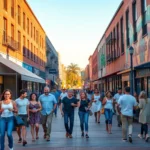Most dangerous neighborhoods in Philadelphia: shocking truth revealed
- Introduction
- Crime in Philadelphia: The Big Picture
- Mapping Out the Most Dangerous Neighborhoods in Philadelphia
- Deep Dive Into Each Risky Neighborhood
- Voices from the Streets: Real Opinions and Stories
- Why Do These Neighborhoods Stay Dangerous?
- Safety Tips for Navigating Philadelphia’s Rough Areas
- Comparing Philadelphia’s Dangerous Neighborhoods with Other Risky Towns in the US
- How Philly Is Fighting Back: Community and Police Initiatives
- What You Need to Know About Philadelphia’s Most Dangerous Neighborhoods
- Sources and Further Reading
Introduction
Philadelphia is a city known for its rich history, vibrant culture, and passionate communities. But like many big cities in the US, it also has its share of risky neighborhoods that locals and visitors alike keep an eye on. Understanding the most dangerous neighborhoods in Philadelphia matters whether you’re thinking about moving, visiting, or just want to stay informed about safety in the City of Brotherly Love.
This article dives deep into the reality behind Philly’s sketchy and gritty areas, exploring crime data, real stories from residents, and practical tips to stay safe. We’ll also look at how communities and police are working to turn things around in these high crime zones Philadelphia is known for.
Crime in Philadelphia: The Big Picture
Crime in Philadelphia is tracked through police reports, crime maps, and statistics that get updated regularly. The city’s police department and independent organizations publish data on incidents ranging from violent crimes like assaults and shootings to property crimes such as burglaries and thefts.
In Philly, the most common types of crime in these rough areas in Philadelphia include violent offenses, drug-related crimes, and property crimes. When people talk about a neighborhood being dodgy or risky, they usually mean there’s a higher chance of encountering these incidents, especially after dark or in less patrolled spots.
To put it in perspective, Philadelphia’s crime rate is often compared with other major US cities. While it has some gritty neighborhoods, it’s not alone in facing these challenges. Cities like Detroit and Baltimore share similar struggles with unsafe parts of US cities, though Philly has unique factors shaping its crime landscape.
Mapping Out the Most Dangerous Neighborhoods in Philadelphia
Using the latest crime data and maps, several neighborhoods stand out as high crime zones Philadelphia residents often mention:
- Kensington
- Nicetown-Tioga
- Fairhill
- Strawberry Mansion
- Hunting Park
- Frankford
- Olney
- West Philadelphia
- North Philadelphia
- Tioga
These areas experience a mix of violent incidents, burglaries, gang activity, and drug offenses. Their reputations didn’t form overnight; decades of economic hardship, urban decay, and social challenges contribute to the sketchy reputation.
Visual crime heat maps show hotspots along streets like Kensington Avenue and parts of North Philadelphia, highlighting where incidents cluster most heavily.
Deep Dive Into Each Risky Neighborhood
Kensington
Kensington is often called the heart of Philly’s drug trade. Residents and police reports highlight ongoing struggles with violent crime and drug-related offenses. The neighborhood’s gritty streets have seen efforts to combat these issues, but challenges remain.
Nicetown-Tioga
Nicetown-Tioga is considered one of the worst areas in Philadelphia. It faces high rates of violent crime and property offenses. Locals describe it as a dicey place with pockets of abandoned homes and busted blocks.
Fairhill and Harrowgate
These neighborhoods have rough areas in Philadelphia marked by ongoing safety concerns. Residents warn about shady spots and advise caution, especially at night.
Strawberry Mansion
Strawberry Mansion struggles with crime but also has a strong community working to improve safety. It’s a neighborhood with a tough past but hopeful residents.
Hunting Park and Frankford
Locals describe these as dodgy spots in America, with incidents of gang activity and sporadic violence. Community efforts focus on reclaiming public spaces and boosting police presence.
Olney and West Philadelphia
These are mixed neighborhoods with some safer blocks but also risky zones. Crime tends to be localized, and residents share tips on which streets to avoid after dark.
Tioga and North Philadelphia
These areas show complex crime patterns. While some blocks are sketchy, others have seen improvements thanks to community programs and increased policing.
Voices from the Streets: Real Opinions and Stories
“Living in Kensington means you have to be aware of your surroundings all the time. The drug trade is real, but there’s also a lot of people trying to make a change.” – Local resident, Kensington
Source: Reddit Philly Discussion
“Fairhill has its problems, but the community is tight. We look out for each other and want visitors to know which blocks to be careful on.” – Community leader
Source: MSN Travel Report
“The police are stepping up patrols in Hunting Park, but it’s still a place where you want to avoid walking alone at night.” – Philly Police Officer
Source: GIS Geography Crime Map
Violent Crime Rates in Major US Cities (per 100k people)
Philadelphia
~1,000
Detroit
~1,600
Baltimore
~1,200
St. Louis
~1,900
Community policing, nonprofit programs
Neighborhood watches, police task forces
Community outreach, tech-driven policing
Grassroots initiatives, increased patrols
Philly’s violent crime rate is high but still lower than Detroit and St. Louis. Each city faces unique challenges, but community efforts and police programs are making a difference. Staying informed helps locals and visitors stay safe and support positive change.
Why Do These Neighborhoods Stay Dangerous?
Root causes like poverty, unemployment, and lack of resources play a big role in keeping crime rates high in these hazardous districts in Philly. Gang activity and drug markets sustain cycles of violence and property crime.
Abandoned homes and busted blocks contribute to urban decay, which affects community morale and safety perceptions. Police presence varies, with some neighborhoods experiencing less nighttime patrols, making certain streets feel risky after dark.
Community policing efforts and local initiatives aim to improve trust and reduce crime, but systemic issues take time to address.
- Check updated crime maps and police reports before visiting or moving to unfamiliar neighborhoods.
- Avoid walking alone at night in sketchy or poorly lit areas.
- Use well-traveled routes and stay in areas with visible police presence.
- Keep emergency contacts handy and know where local community centers or safe spots are.
- Listen to local advice from residents and online forums like Reddit for current safety tips.
- Be aware of surroundings and avoid displaying valuables openly.
Remember, many neighborhoods are improving, so staying informed helps you navigate safely.
Comparing Philadelphia’s Dangerous Neighborhoods with Other Risky Towns in the US
Philadelphia shares some crime challenges with cities like Detroit, Baltimore, and St. Louis. All face issues with violent crime, drug offenses, and economic hardship.
| City | Violent Crime Rate (per 100k) | Common Crime Types | Community Response |
|---|---|---|---|
| Philadelphia | ~1,000 | Violent crime, drug offenses, burglaries | Community policing, nonprofit programs |
| Detroit | ~1,600 | Violent crime, property crime | Neighborhood watches, police task forces |
| Baltimore | ~1,200 | Violent crime, drug-related offenses | Community outreach, tech-driven policing |
| St. Louis | ~1,900 | Violent crime, gang activity | Grassroots initiatives, increased patrols |
While Philly’s numbers are high, ongoing efforts show promise in reducing crime and improving safety.
How Philly Is Fighting Back: Community and Police Initiatives
Philadelphia has launched several programs targeting crime reduction in its sketchy neighborhoods in Philly. These include:
- Community policing to build trust between police and residents
- Nonprofit organizations offering youth programs to steer kids away from gangs
- Technology-driven crime analysis to deploy resources efficiently
- Neighborhood clean-up and housing rehab projects to fight urban decay
Success stories exist, like reduced violent incidents in some blocks of West Philadelphia, but challenges remain. Residents and police agree that collaboration is key to reclaiming these bad hoods in the US.
What You Need to Know About Philadelphia’s Most Dangerous Neighborhoods
The worst areas in Philadelphia are shaped by complex social and economic factors. While these dodgy spots in America have higher crime rates, they’re also home to resilient communities working hard for change.
Understanding the high crime zones Philadelphia helps locals and visitors stay safe and avoid risky situations. It’s important to look beyond stereotypes and recognize the human stories behind the statistics.
Stay informed, stay cautious, and remember that many neighborhoods are on a path toward improvement.

Sources and Further Reading
What do you think about the safety situation in Philadelphia’s neighborhoods? Have you had experiences in any of these areas? How would you like to see communities and police work together to make these places safer? Share your thoughts, questions, or stories in the comments below!
 Is it safe to walk in Philadelphia at night? What no one tells you!
Is it safe to walk in Philadelphia at night? What no one tells you! Is Philadelphia crime rate for expats worse than you think?
Is Philadelphia crime rate for expats worse than you think? Is Stockton safe to visit? The shocking truth no one tells you
Is Stockton safe to visit? The shocking truth no one tells youSi quieres conocer otros artículos parecidos a Most dangerous neighborhoods in Philadelphia: shocking truth revealed puedes visitar la categoría Pennsylvania.

Leave a Reply